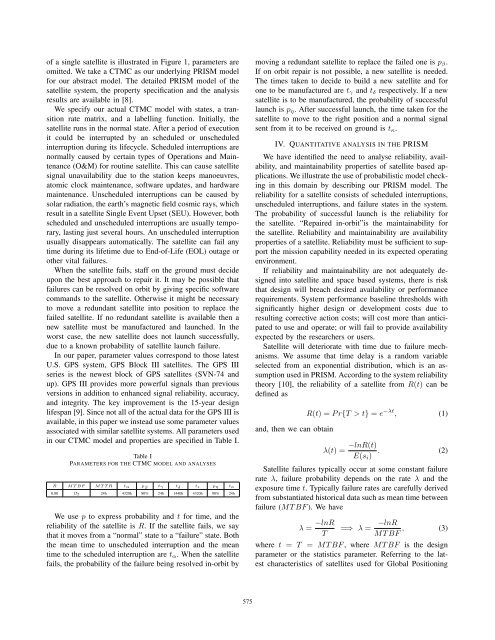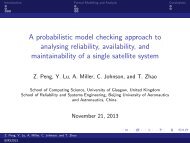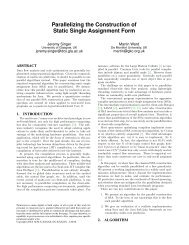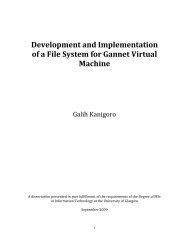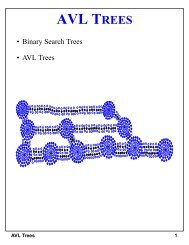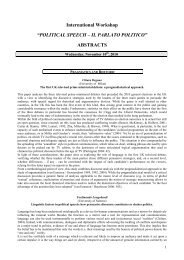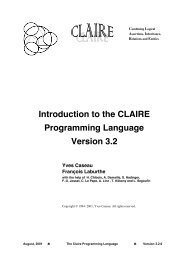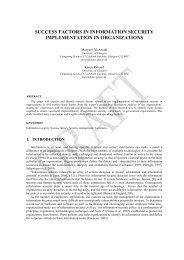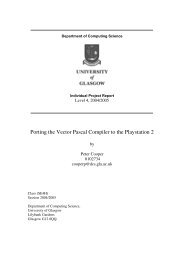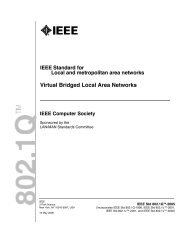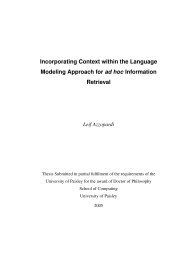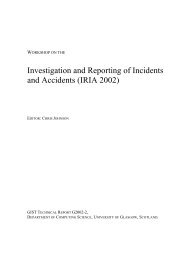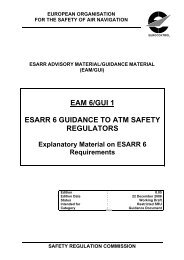A Probabilistic Model Checking Approach to Analysing Reliability ...
A Probabilistic Model Checking Approach to Analysing Reliability ...
A Probabilistic Model Checking Approach to Analysing Reliability ...
Create successful ePaper yourself
Turn your PDF publications into a flip-book with our unique Google optimized e-Paper software.
of a single satellite is illustrated in Figure 1, parameters are<br />
omitted. We take a CTMC as our underlying PRISM model<br />
for our abstract model. The detailed PRISM model of the<br />
satellite system, the property specification and the analysis<br />
results are available in [8].<br />
We specify our actual CTMC model with states, a transition<br />
rate matrix, and a labelling function. Initially, the<br />
satellite runs in the normal state. After a period of execution<br />
it could be interrupted by an scheduled or unscheduled<br />
interruption during its lifecycle. Scheduled interruptions are<br />
normally caused by certain types of Operations and Maintenance<br />
(O&M) for routine satellite. This can cause satellite<br />
signal unavailability due <strong>to</strong> the station keeps manoeuvres,<br />
a<strong>to</strong>mic clock maintenance, software updates, and hardware<br />
maintenance. Unscheduled interruptions can be caused by<br />
solar radiation, the earth’s magnetic field cosmic rays, which<br />
result in a satellite Single Event Upset (SEU). However, both<br />
scheduled and unscheduled interruptions are usually temporary,<br />
lasting just several hours. An unscheduled interruption<br />
usually disappears au<strong>to</strong>matically. The satellite can fail any<br />
time during its lifetime due <strong>to</strong> End-of-Life (EOL) outage or<br />
other vital failures.<br />
When the satellite fails, staff on the ground must decide<br />
upon the best approach <strong>to</strong> repair it. It may be possible that<br />
failures can be resolved on orbit by giving specific software<br />
commands <strong>to</strong> the satellite. Otherwise it might be necessary<br />
<strong>to</strong> move a redundant satellite in<strong>to</strong> position <strong>to</strong> replace the<br />
failed satellite. If no redundant satellite is available then a<br />
new satellite must be manufactured and launched. In the<br />
worst case, the new satellite does not launch successfully,<br />
due <strong>to</strong> a known probability of satellite launch failure.<br />
In our paper, parameter values correspond <strong>to</strong> those latest<br />
U.S. GPS system, GPS Block III satellites. The GPS III<br />
series is the newest block of GPS satellites (SVN-74 and<br />
up). GPS III provides more powerful signals than previous<br />
versions in addition <strong>to</strong> enhanced signal reliability, accuracy,<br />
and integrity. The key improvement is the 15-year design<br />
lifespan [9]. Since not all of the actual data for the GPS III is<br />
available, in this paper we instead use some parameter values<br />
associated with similar satellite systems. All parameters used<br />
in our CTMC model and properties are specified in Table I.<br />
Table I<br />
PARAMETERS FOR THE CTMC MODEL AND ANALYSES<br />
R MTBF MTTR tα p β tγ t δ tɛ pη tκ<br />
0.80 15y 24h 4320h 80% 24h 1440h 4320h 90% 24h<br />
We use p <strong>to</strong> express probability and t for time, and the<br />
reliability of the satellite is R. If the satellite fails, we say<br />
that it moves from a “normal” state <strong>to</strong> a “failure” state. Both<br />
the mean time <strong>to</strong> unscheduled interruption and the mean<br />
time <strong>to</strong> the scheduled interruption are t α . When the satellite<br />
fails, the probability of the failure being resolved in-orbit by<br />
moving a redundant satellite <strong>to</strong> replace the failed one is p β .<br />
If on orbit repair is not possible, a new satellite is needed.<br />
The times taken <strong>to</strong> decide <strong>to</strong> build a new satellite and for<br />
one <strong>to</strong> be manufactured are t γ and t δ respectively. If a new<br />
satellite is <strong>to</strong> be manufactured, the probability of successful<br />
launch is p η . After successful launch, the time taken for the<br />
satellite <strong>to</strong> move <strong>to</strong> the right position and a normal signal<br />
sent from it <strong>to</strong> be received on ground is t κ .<br />
IV. QUANTITATIVE ANALYSIS IN THE PRISM<br />
We have identified the need <strong>to</strong> analyse reliability, availability,<br />
and maintainability properties of satellite based applications.<br />
We illustrate the use of probabilistic model checking<br />
in this domain by describing our PRISM model. The<br />
reliability for a satellite consists of scheduled interruptions,<br />
unscheduled interruptions, and failure states in the system.<br />
The probability of successful launch is the reliability for<br />
the satellite. “Repaired in-orbit”is the maintainability for<br />
the satellite. <strong>Reliability</strong> and maintainability are availability<br />
properties of a satellite. <strong>Reliability</strong> must be sufficient <strong>to</strong> support<br />
the mission capability needed in its expected operating<br />
environment.<br />
If reliability and maintainability are not adequately designed<br />
in<strong>to</strong> satellite and space based systems, there is risk<br />
that design will breach desired availability or performance<br />
requirements. System performance baseline thresholds with<br />
significantly higher design or development costs due <strong>to</strong><br />
resulting corrective action costs; will cost more than anticipated<br />
<strong>to</strong> use and operate; or will fail <strong>to</strong> provide availability<br />
expected by the researchers or users.<br />
Satellite will deteriorate with time due <strong>to</strong> failure mechanisms.<br />
We assume that time delay is a random variable<br />
selected from an exponential distribution, which is an assumption<br />
used in PRISM. According <strong>to</strong> the system reliability<br />
theory [10], the reliability of a satellite from R(t) can be<br />
defined as<br />
and, then we can obtain<br />
R(t) =Pr{T >t} = e −λt , (1)<br />
λ(t) = −lnR(t)<br />
E(s i ) . (2)<br />
Satellite failures typically occur at some constant failure<br />
rate λ, failure probability depends on the rate λ and the<br />
exposure time t. Typically failure rates are carefully derived<br />
from substantiated his<strong>to</strong>rical data such as mean time between<br />
failure (MTBF). We have<br />
λ = −lnR<br />
T<br />
=⇒ λ = −lnR<br />
MTBF , (3)<br />
where t = T = MTBF, where MTBF is the design<br />
parameter or the statistics parameter. Referring <strong>to</strong> the latest<br />
characteristics of satellites used for Global Positioning<br />
575


